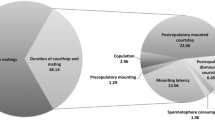Summary
-
1.
A population ofColostethus inguinalis, a small diurnally active frog, was studied along a stream in seasonal tropical forest on Cerro Campana, Panama, from January through November 1976. Females laid eggs on land and carried up to 40 tadpoles on their backs to water. Tadpoles remained on their mothers' backs for up to 9 days. Sexual maturity was reached about 4–6 months after metamorphosis.
-
2.
Some females produced two clutches in 11 months. The average interval between clutches was 133 days. Reproduction occurred in every month except April, with a peak in May and June, the beginning of the wet season. Reproduction decreased in the wettest months.
-
3.
C. inguinalis has three vocalizations: an advertisement call, an encounter call used to challenge territorial intruders, and a close-range encounter call given just before an attack. The first two are given only by males, the last by females as well.
-
4.
Agonistic behavior included postural displays, chases, attacks, and wrestling. Encounters between same sex individuals were more likely to end in wrestling than those between males and females. Males were more effective than females in repelling intruders without physical contact.
-
5.
Courtship was prolonged and involved closerange vocal, visual, and tactile interactions between males and females.
-
6.
The behavior and spatial organization of males and females changed seasonally. Both sexes defended small territories near pools in the dry season, although males remained in one place longer than most females. In the wet season, males defended widely dispersed territories ten times the size of dry season territories. Females were more mobile and seldom defended territories for more than a few days at a time. Dry season territories appeared to provide access to moist retreats and feeding sites in short supply. Large male wet season territories were used for feeding, shelter, courtship, and mating.
-
7.
Both males and females defended territories against frogs of other species, but only encounters between maleC. inguinalis and maleColostethus pratti were frequent. Most of these occurred in the dry season, when the two species competed for the same retreats. There is some evidence that the two species can perceive each other's vocalizations.
Similar content being viewed by others
References
Bunnell, P.: Vocalizations in the territorial behavior of the frogDendrobates pumilio. Copeia1973, 277–284 (1973)
Crump, M.L.: Territoriality and mating behavior inDendrobates granuliferus (Anura: Dendrobatidae). Herpetologica28, 195–198 (1972)
Dole, J.W., Durant, P.: Courtship behavior inColostethus collaris (Dendrobatidae). Copeia1974, 988–990 (1974)
Duellman, W.E.: Aggressive behavior in dendrobatid frogs. Herpetologica22, 217–221 (1966)
Duellman, W.E.: The hylid frogs of Middle America. Lawrence, Kansas: University of Kansas 1970
Durant, P., Dole, J.W.: Aggressive behavior inColostethus (=Prostherapis) collaris (Anura: Dendrobatidae). Herpetologica31, 23–26 (1975)
Fleming, T.H., Hooker, R.S.:Anolis cupreus: The response of a lizard to tropical seasonality. Ecology56, 1243–1261 (1975)
Fleming, T.H., Hooker, E.T., Wilson, D.E.: Three Central American bat communities: Structure, reproductive cycles, and movement patterns. Ecology53, 555–569 (1972)
Fogden, M.P.L.: The seasonality and population dynamics of equatorial forest birds in Sarawak. Ibis114, 307–343 (1972)
Goodman, D.E.: Territorial behavior in a neotropical frog,Dendrobates granuliferus. Copeia1971, 365–370 (1971)
Lüddecke, H.: Ethologische Untersuchungen zur Fortpflanzung vonPhyllobates palmatus (Amphibia, Ranidae). Ph. D. Dissertation, Johannes Gutenberg-Universität, Mainz (1974)
Lüddecke, H.: Einige Ergebnisse aus Feldbeobachtungen anPhyllobates palmatus (Amphibia, Ranidae) in Kolumbien. Mitt. Inst. Colombo Aleman Invest. Cient. Punta de Betin8, 157–163 (1976)
McDianmid, R.W.: Evolution of parental care in frogs. In The development of behavior: comparative and evolutionary aspects. Burghardt, G.M., Beckoff, M. (eds.), pp. 127–147. New York: Garland 1978
Myers, C.W., Daly, J.W., Malkin, B.: A dangerously toxic new frog (Phyllobates) used by Embera Indians of western Colombia, with discussion of blowgun fabrication and dart poisoning. Bull. Am. Mus. Nat. Hist.161, 307–366 (1978)
Savage, J.M.: The dendrobatid frogs of Central America. Copeia1968, 745–776 (1968)
Senfft, W.: Das Brutgeschäft des Baumsteigerfrosches (Dendrobates auratus Girard) in Gefangenschaft. Zool. Gart.8, 122–136 (1936)
Sexton, O.J.: Some aspects of the behavior and of the territory of a dendrobatid frog,Prostherapis trinitatis. Ecology41, 107–115 (1960)
Sexton, O.J., Ortleb, E.P., Hathaway, L.M., Ballinger, R.E., Licht, P.: Reproductive cycles of three species of anoline lizards from the Isthmus of Panama. Ecology52, 201–215 (1971)
Silverstone, P.A.: Observations on the behavior and ecology of a Colombian poison-arrow frog, the Kokoe-pa (Dendrobates histrionicus Berthold). Herpetologica29, 295–301 (1973)
Smythe, N.: The natural history of the Central American agouti (Dasyprocta punctata). Smithson. Contrib. Zool.257, 1–52 (1978)
Sokal, R.R., Rohlf, F.J.: Biometry. San Francisco: Freeman 1969 Test, F.H.: Social aggressiveness in an amphibian. Science120, 140–141 (1954)
Meeuwen, H.M. Van: De Trinidadse beekkikkerColostethus trinitatis. Lacerta36, 3–11 (1977)
Verner, J.: On the adaptive significance of territoriality. Am. Nat.111, 769–775 (1977)
Wells, K.D.: The social behaviour of anuran amphibians. Anim. Behav.25, 666–693 (1977a)
Wells, K.D.: The courtship of frogs. In: The reproductive biology of amphibians. Taylor, D.H., Guttman, S.I. (eds.), pp. 233–262. New York: Plenum (1977b)
Wells, K.D.: Courtship and parental behavior in a Panamanian poison-arrow frog (Dendrobates auratus). Herpetologica34, 148–155 (1978)
Wells, K.D.: Parental behavior of male and female frogs. In: Natural selection and social behavior: Recent research and new theory. Alexander, R.D., Tinkle, D. (eds.). Newton, Mass: Chiron Press (in press) 1979a
Wells, K.D.: Social behavior and communication in a dendrobatid frog (Colostethus trinitatis). Herpetologica (in press) (1979b)
Author information
Authors and Affiliations
Rights and permissions
About this article
Cite this article
Wells, K.D. Behavoral ecology and social organization of a dendrobatid frog (Colostethus inguinalis). Behav Ecol Sociobiol 6, 199–209 (1980). https://doi.org/10.1007/BF00569201
Received:
Accepted:
Issue Date:
DOI: https://doi.org/10.1007/BF00569201




